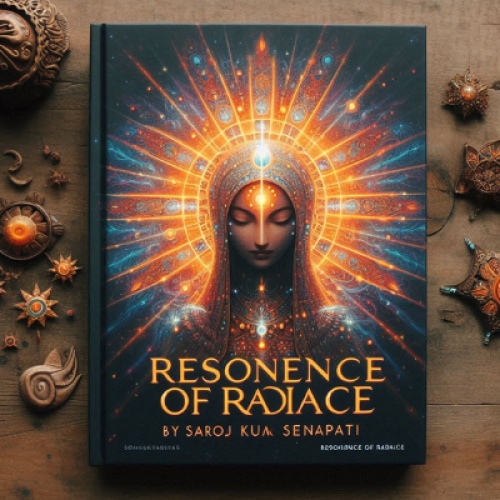The Resonance of Radiance
In a city burdened by stress and ambition, Aria Mehra, an engineer and dreamer, sought to bring positivity to people's lives. Among her inventive ideas, one stood out - the "Positivity Prism," a device that transformed negative emotions into uplifting light, sound, and vibrations using advanced sensors and algorithms.
The idea was inspired by a prism her late father had cherished, which scattered light into vibrant colors. Aria envisioned a device that could do the same for emotions, turning grief into hope. With a team of neuroscientists and psychologists, she developed the Prism - a sleek, palm-sized pyramid that responded to users' emotions, offering personalized affirmations, visuals, and sounds.
The Prism debuted at "A Day of Light," where attendees shared emotions and saw them transformed. Aria demonstrated its power by reminiscing about her father, as the Prism glowed golden and played his favorite lullaby. The device became a sensation, helping individuals find joy and connection
Aria expanded the Prism's reach, partnering with schools, hospitals, and workplaces to foster emotional expression and gratitude. Community installations uplifted collective moods, casting rainbow lights onto city streets. While critics raised concerns about dependency, Aria emphasized the Prism as a tool to uncover inner strength.
Innovations followed - bracelet versions, apps, and even Prisms for pets. Yet the original Prism remained a personal symbol for Aria, reminding her of the light born from her darkest days. As she gazed at the glowing city, she whispered, "Thank you, Dad," holding the Prism - a testament to the transformative power of hope and invention
The Resonance of Radiance
In a bustling city weighed down by deadlines, traffic jams, and relentless routines, positivity had faded into rarity. People walked with furrowed brows, clutching their ambitions but feeling burdened by them. It was in this city that Aria Mehra, an engineer with an imaginative streak and an undying curiosity, decided to create something transformative - a way to restore lightness to people's lives.
Aria's evenings were often spent sketching futuristic ideas. Her imagination danced to whimsical concepts, including self-painting walls that mirrored your mood, shoes whispering affirmations with each step, and pens that played soft melodies while you wrote. Yet, among these inventions, her most extraordinary idea emerged - the "Positivity Prism."
An Inspiration Born of Loss
The origin of this invention came from one of the darkest chapters of Aria's life. A year before, she had lost her father, her biggest supporter and source of strength, to illness. As grief consumed her days, Aria often sat on her terrace, gazing at the glittering city lights with a heavy heart. One evening, her mother handed her a keepsake - a small prism her father had cherished. When held to the light, it scattered vibrant colors across the room, filling it with warmth. That simple but profound moment sparked an idea: "If a prism can
In a city burdened by stress and ambition, Aria Mehra, an engineer and dreamer, sought to bring positivity to people's lives. Among her inventive ideas, one stood out - the "Positivity Prism," a device that transformed negative emotions into uplifting light, sound, and vibrations using advanced sensors and algorithms.
The idea was inspired by a prism her late father had cherished, which scattered light into vibrant colors. Aria envisioned a device that could do the same for emotions, turning grief into hope. With a team of neuroscientists and psychologists, she developed the Prism - a sleek, palm-sized pyramid that responded to users' emotions, offering personalized affirmations, visuals, and sounds.
The Prism debuted at "A Day of Light," where attendees shared emotions and saw them transformed. Aria demonstrated its power by reminiscing about her father, as the Prism glowed golden and played his favorite lullaby. The device became a sensation, helping individuals find joy and connection
Aria expanded the Prism's reach, partnering with schools, hospitals, and workplaces to foster emotional expression and gratitude. Community installations uplifted collective moods, casting rainbow lights onto city streets. While critics raised concerns about dependency, Aria emphasized the Prism as a tool to uncover inner strength.
Innovations followed - bracelet versions, apps, and even Prisms for pets. Yet the original Prism remained a personal symbol for Aria, reminding her of the light born from her darkest days. As she gazed at the glowing city, she whispered, "Thank you, Dad," holding the Prism - a testament to the transformative power of hope and invention
The Resonance of Radiance
In a bustling city weighed down by deadlines, traffic jams, and relentless routines, positivity had faded into rarity. People walked with furrowed brows, clutching their ambitions but feeling burdened by them. It was in this city that Aria Mehra, an engineer with an imaginative streak and an undying curiosity, decided to create something transformative - a way to restore lightness to people's lives.
Aria's evenings were often spent sketching futuristic ideas. Her imagination danced to whimsical concepts, including self-painting walls that mirrored your mood, shoes whispering affirmations with each step, and pens that played soft melodies while you wrote. Yet, among these inventions, her most extraordinary idea emerged - the "Positivity Prism."
An Inspiration Born of Loss
The origin of this invention came from one of the darkest chapters of Aria's life. A year before, she had lost her father, her biggest supporter and source of strength, to illness. As grief consumed her days, Aria often sat on her terrace, gazing at the glittering city lights with a heavy heart. One evening, her mother handed her a keepsake - a small prism her father had cherished. When held to the light, it scattered vibrant colors across the room, filling it with warmth. That simple but profound moment sparked an idea: "If a prism can




